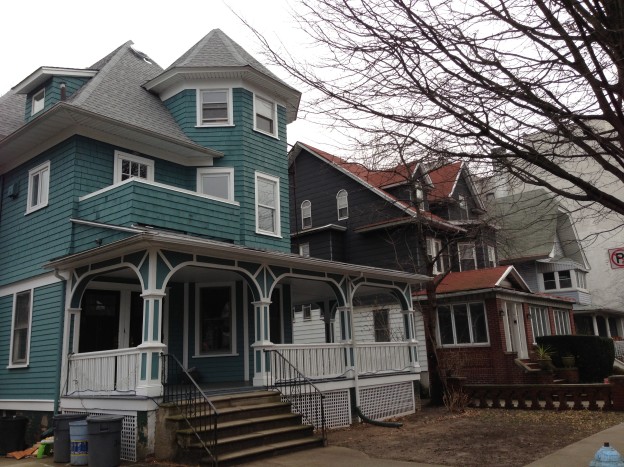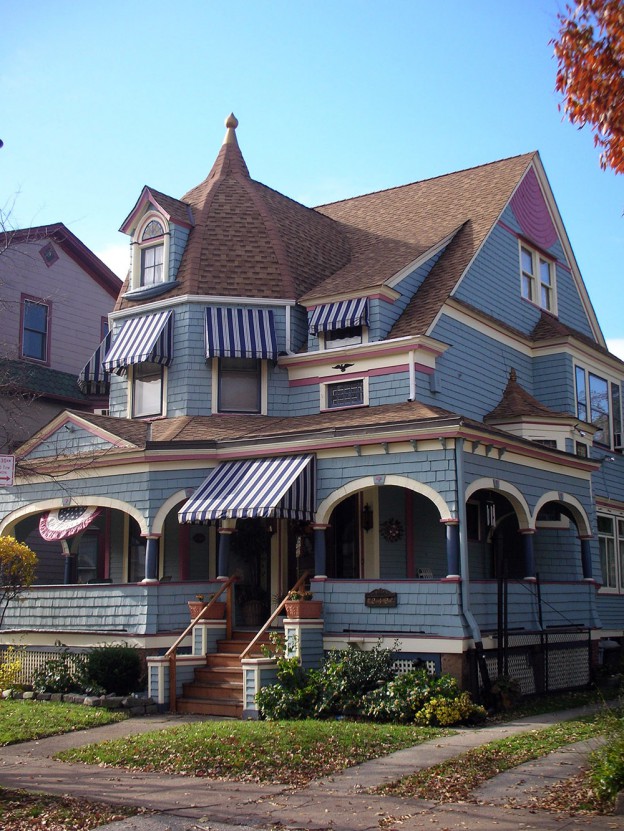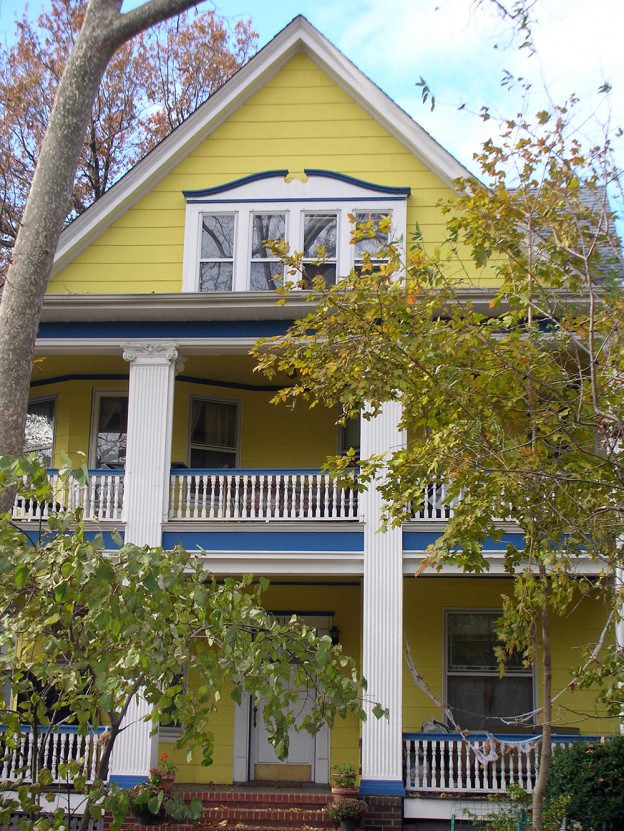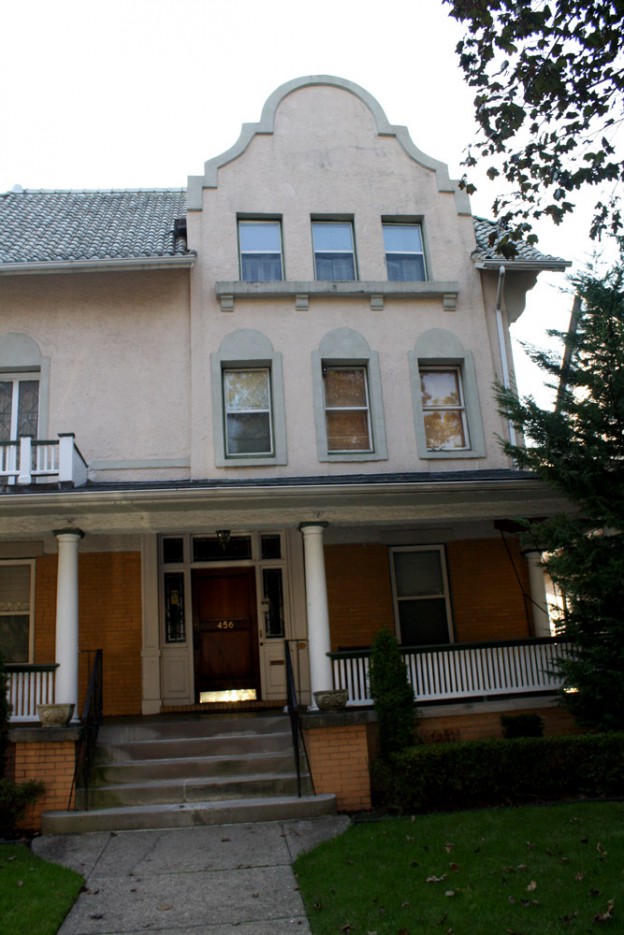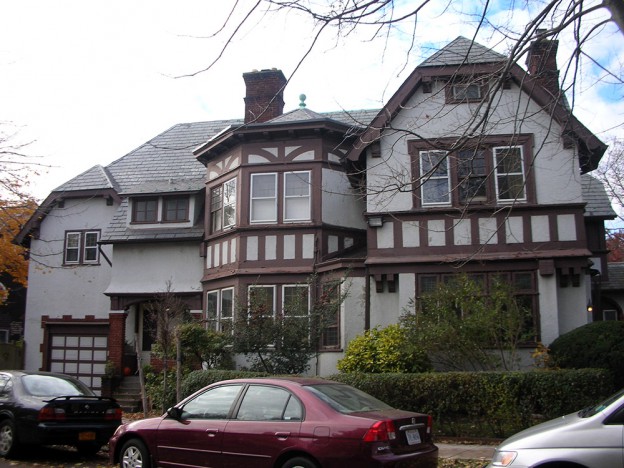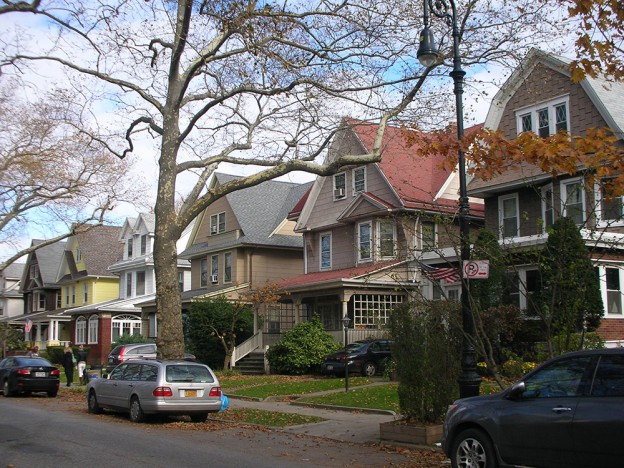Prospect Park South;
94: John J. Petit, 1907;
100: John J. Petit, 1900;
101: John E. Nitchie, 1900;
New York City Historic District;
State and National Registers of Historic Places|
Dean Alvord developed Prospect Park South with homes of nearly uniform size and layout, but achieved variety through the use of often whimsical details. This block contains houses that showcase this concept to great effect, including number 94 in the style of a Spanish Mission and number 100 evoking a Swiss chalet, both on the west side of the road. Across the street, the Shingle Style house at number 101 became famous for its role as a boarding house in the 1982 film “Sophie’s Choice,” starring Meryl Streep and Kevin Kline.
Beverly Square West;
T. B. Ackerson, 1901|
After purchasing and developing the small plot that he named Beverley Square East, T. B. Ackerson then purchased an adjoining farm to create the Beverley Square West neighborhood. While the homes he constructed here also featured many of the same architectural elements, including Palladian windows and grand columns, Beverley Square West was built with the intention that no two houses be exactly alike.
T. B. Ackerson, ca. 1900|
Number 242 was designed in the Shingle Style with arched porch openings and a polygonal onion-shaped tower. Number 305 was built for a female member of the Guggenheim family, and number 312 was once the home of composer and film producer Arthur Schwartz, who was famous for his Broadway and film music of the 1930s, 1940s and 1950s.
Beverly Square East;
T. B. Ackerson, 1898–1901|
Beverley Square East’s first properties were developed by Thomas Benton Ackerson in 1898 along East 19th Street. The houses were well-appointed, with interior wooden moldings and silk wallpaper, as well as such modern amenities as steam heat and electricity. Particularly extravagant examples of Ackerson’s original development are numbers 217, 223 (not pictured) and 247. Number 257 served as Ackerson’s “model home” in sales brochures and advertisements and nearly 100 years later played a role in Spike Lee’s 1992 film “Malcolm X.”
East 18th Street at Dorchester Road;
Ditmas Park;
Church: Allens & Collins, 1910;
Parish house: Whitfield & King, 1899;
New York City Historic District|
The neo-Georgian church, designed by the same firm responsible for the Union Theological Seminary and Riverside Church in Morningside Heights, features a Greek Revival temple front and tower. The earlier parish house was designed in the Shingle Style and its polygonal rounded body has 16 sides.
Ditmas Park;
445: Foster & Gallimore, 1931;
456: Arne Delhi, 1910;
New York City Historic District;
State and National Registers of Historic Places|
These two houses stand across the street from one another. On the east side, number 445 (not pictured) was designed to emulate an English cottage and features multi-colored rough-cut brick, a steeply pitched roof with slate tiles and a large fanciful brick chimney. Number 456 was designed by a Norwegian architect in the Spanish Mission style, but its eclectic contribution to the streetscape also includes a pediment suggesting a Dutch influence.
Ditmas Park West, ca. 1920|
The eclectic mix of homes in Ditmas Park West is the work of multiple builders who purchased lots from Lewis Pounds (who would later become Brooklyn Borough President) beginning in 1903. This neo-Tudor house is particularly notable because it is rumored to have been the home of Mary Pickford and Douglas Fairbanks, film stars of the 1920s and 1930s.
1907|
The oldest purpose-built outdoor shopping plaza in America, Newkirk Plaza is home to some of the area’s longest-standing businesses, including Leon’s Barber Shop, which has been in operation for roughly 100 years. Below the plaza is the Brighton subway line, which was “sunk” below street level in 1917. Turning north up East 16th Street, the block between Newkirk and Ditmas Avenues is home to a group of 13 bungalows constructed in 1908–09 after designs by Arlington Isham.
South Midwood;
Unknown architect, ca. 1866|
South Midwood was developed by the Germania Real Estate and Improvement Company and its homes were largely designed by Benjamin Driesler in 1899–1908. Number 527 predates the neighborhood’s development by several decades, as it is believed to have been built in the 1860s. The farm house, which was moved from its original location somewhere near the present-day Regent Place and modernized around 1910, was the home of Henry Lyles Jr., a sperm whale oil dealer and president of both the Flatbush Gas Works and the Bowery Savings Bank. Though it has undergone some major renovations over the years, the house stands as a reminder of what came before the grand Victorians.
West Midwood;
T. B. Ackerson, 1905–08|
Developed by the Germania Real Estate and Improvement Company, the neighborhood of West Midwood was developed in a more methodical way than some of the others. Though still architecturally grand and of a high quality, the houses were mass-produced to take advantage of successful real estate operations in the area.


